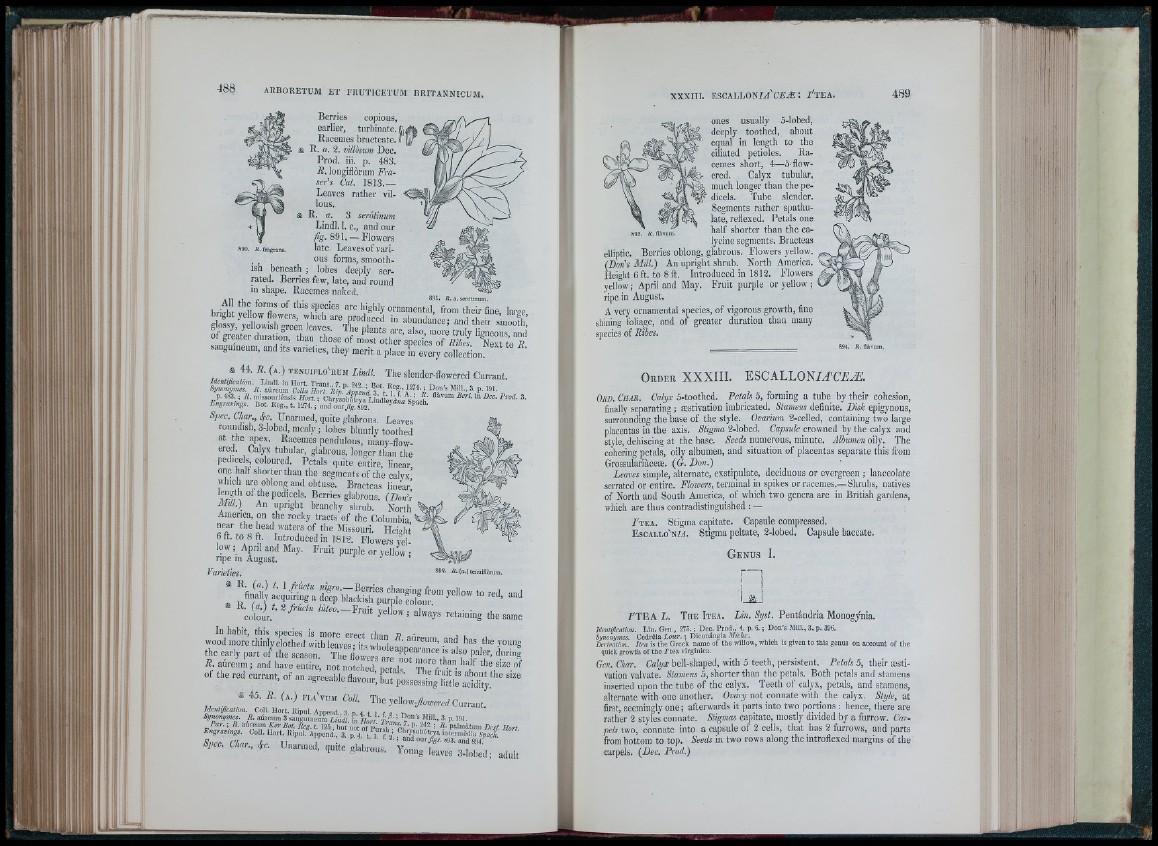
f I
Berries copious,
earlier, turbinate. i
Racemes bracteate. i,
sii R. a. 2. villomm Dec.
Prod. iii. p. 483.
R. longiflòrum Fra-
sei''s Cat, 18] 3.—
Leaves rather villous.
i R. a. 3 serótinum
Lindl. I, c., and our
fig. 891. — Flowers
late. Leavesofvarious
forms, smooth-
beneath
----------- , lobes deeply serrated.
Berries few, late, and round
in shape. Racemes naked.
brirfl't le L w T ! "ro oraamentat'fr^ìThSrfine, large,
sanguineum, and its vai-iet.es, they merit a place in every eollection
* ‘i- (''■) te n u iflo 'b um Lindi. The slender-flowered Currant.
1274. ; Don’s Mill., 3. p. 191.
R . flàvum Beri, in Dec. Prod. 3.
R . (a.) temiiflòrum.
■A A • , —.V. VACl ju g .
Spec. Char f r Unarmed, quite glabrous. Leaves
roundish, 3-Iobed, mealy ; lobes bluntly toothed
at the apex. Racemes pendulous, many-flowered.
Calyx tubular, glabrous, longer than the
pedicels coloured. Petals quite entire, linear
one half shorterthan the segments of the calyx
which are oblong and obtuse. Bracteas linea.-;
S w ! ° ! pedicels. Berries glabrous. (Doris
MiU.) An upright branchy shrub. North
America, on the rocky tracts of the Cohimhia, ’
near the. head waters of the Missouri Hei-dit
6 ft. to 8 ft. Introduced in 1812. Flower.s rel-
low ; April and May. Fruit purple or yellow •
npe in August. ’
Varieties.
■ -
¿ o lo ? . -® ^ ''“ "“ yellow, always retaining the same
wood mori thinly cfoth^eV^thZveTMtZ^hdefrin?'^®“™’ " " I
the early part of the season. The f l o l ? ± f " f t I’" '“ ’ “" " "g
iî. aúreum ; and have entire, not notched ¿etals e/1’.“ . “ f t R e size of
of the red currant, of an agreeable flavoni’, ? . t p i s e l i ? ? ? , " a Z " ? * ® "^®
M rs 7 T T The 3'eIlow->„„.«, Ci.rra.it,
Syrumumes. R. a û t e u / Í8 a i¡ e ” i n á íS ° Í * ; J ; m
I “r... a . tmream Ka-Bot. Reg. t. 125., but not of ph rÌh . r h , ' / ' I>“>màtum Desf. Hort
Engravmgs. Coll. Hort. Ilipiü. Append., 3. p L t. 1 f 2 . m d Sn,„.¡,
Spec. Chnr., fr . Unarmed, quite glabrous.
Young leaves 3-lobed; adult
ones usually 5-lobed,
deeply toothed, about
equal in length to the
ciliated petioles. Racemes
short, 4—5 flowered.
Calyx tubular,
much longer than the pedicels.
Tube slender.
Segments rather spathulate,
reflexed. Frétais one
half shorter than the calycine
segments. Bracteas
S93. R . flàTum
elliptic. Berries oblong, glabrous. Flowers yellow.
(Doris Milt.) An upright shrub. North America.
Height 6 ft. to 8 ft. Introduced in 1812. Flowers
yellow ; April and May. Fruit purple or yellow ;
ripe in August.
A very ornamental species, of vigorous growth, fine
shining foliage, and of greater duration than many
species of Ribes.
894. Ä. flàvum.
O r d e r X X X I I I . ESCALLON7z4'C£Æ.
O r d . C h a r . Calyx 5-toothed. Petals 5, forming a tube by their cohesion,
finally separating ; æstivation imbricated. Stamens definite. Disk epigynous,
surrounding the base of the style. Ovarium 2-celled, containing two large
placentas in the axis. Stigma 2-lobed. Capsule crowned by the calyx and
style, dehiscing at the base. Seeds numerous, minute. Albumen oily. The
cohering petals, oily albumen, and situation of placentas separate this from
Grossulariàceæ. (G. Don.)
Leaves simple, alternate, exstipulate, deciduous or evergreen ; lanceolate
serrated or entire. Flowers, terminal in spikes or racemes.—Shrubs, natives
of North and South America, of which two genera are in British gardens,
which are thus contradistinguished : —
/ ' t e a . Stigma capitate. Capsule compressed.
E s c a l l o 'n 7 a 4 . Stigma peltate, 2-lobed. Capsule baccate.
G e n u s I.
/'T E A L. T h e I t e a . Lin. Syst. Pentándria Monogynia.
Identification. Lin. Gen., 275.; Dec. Prod., 4. p. 6 .; Don’s Mill., 3. p. 396.
Synonymes. Cedréla Lour. ; Diconángia Michx. _
Berivation. Itea is the Greek name of the willow, which is given to this genus on account of the
quick growth of the /'te a virginica.
Gen. Char. Calyx bell-shaped, with 5 teeth, persistent. Petals 5, their e s tivation
valvate. Stamens 5, shorter than the petals. Both petals and stamens
inserted upon the tube of the calyx. Teeth of calyx, petaks, and stamens,
alternate with one another. Ovary not connate with the calyx. Style, at
first, seemingly one; afterwards it parts into two portions : hence, there are
rather 2 styles connate. Stigmas capitate, mostly divided by a furrow. Carpels
two, connate into a capsule of 2 cells, that has 2 furrow.s, and parts
from bottom to top. Seeds in two rows along the introflexed margins of the
carpels. (Dee. Prod.)
J l